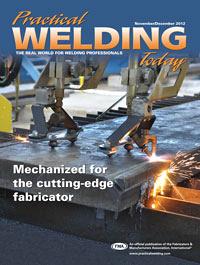Independent welding consumables professional
- FMA
- The Fabricator
- FABTECH
- Canadian Metalworking
Categories
- Additive Manufacturing
- Aluminum Welding
- Arc Welding
- Assembly and Joining
- Automation and Robotics
- Bending and Forming
- Consumables
- Cutting and Weld Prep
- Electric Vehicles
- En Español
- Finishing
- Hydroforming
- Laser Cutting
- Laser Welding
- Machining
- Manufacturing Software
- Materials Handling
- Metals/Materials
- Oxyfuel Cutting
- Plasma Cutting
- Power Tools
- Punching and Other Holemaking
- Roll Forming
- Safety
- Sawing
- Shearing
- Shop Management
- Testing and Measuring
- Tube and Pipe Fabrication
- Tube and Pipe Production
- Waterjet Cutting
Industry Directory
Webcasts
Podcasts
FAB 40
Advertise
Subscribe
Account Login
Search
Consumables Corner: Longitudinal cracking: A check list for prevention
- By Nino Mascalco
- June 18, 2014
- Article
- Consumables
Q: We are welding several fabricated parts made from A514 (T1) steel using an AWS A5.29, 3/32-in-dia. E110 FCAW electrode. On one particular part we are experiencing longitudinal weld cracking. The structure is a 4-in. plate with a square cut out of the center and a 1.5-in. plate welded back in its place. We are following preheats recommended for the varying thicknesses, so what’s the problem?
A: It’s not uncommon to find longitudinal cracking on this type of fabrication. This type of scenario is considered one of the highest-restrained joints that can be created. If this were A36 steel, a simple increase in preheat temperature and longer slow cooling would resolve the problem. However, A514 steel is quenched and tempered, meaning excessive preheating can affect the material’s mechanical properties negatively, so you must use caution.
In many cases, if you adhere to proper weld preheat and slow-cooling practices and still are experiencing cracking, the cause may be one or a combination of things:
- You are using improper welding parameters, such as excessive voltage or lack of wire.
- You are terminating the weld bead incorrectly or you are stacking the weld starts/stops.
- Your welding technique is incorrect.
- The weld bead size and sequence are incorrect.
Typically with this wire classification, the welder tends to decrease the wire feed speed in an attempt to reduce the amount of spatter and smooth out the arc. Unfortunately, the net effect of this adjustment is a wider, shallower weld bead resulting in higher alloy dilution from the base material into the weld, which makes it more susceptible to centerline cracking. As the bead solidifies, there is not enough filler metal in the throat of the weld to accommodate the weld shrinkage. Be sure to follow the wire manufacturer’s recommended weld parameters.
Also be sure to stagger the weld bead starts and stops throughout the joint and avoid them in the plate corners. Always follow proper crater fill techniques when making the weld.
Since this is a flux-cored wire, make sure to use a “drag” technique. This technique will produce a weld with better penetration, and it also prevents the weld beads from getting too flat and shallow.
Finally, the weld beads should be staggered in an alternating fashion around the joint; that is, alternate between sides of the weld joint and between sides of the plate if it is welded on both sides. This effort will help balance out the residual stresses and prevent excessive stress buildup in one location.
About the Author

About the Publication
Related Companies
subscribe now

The Welder, formerly known as Practical Welding Today, is a showcase of the real people who make the products we use and work with every day. This magazine has served the welding community in North America well for more than 20 years.
start your free subscription- Stay connected from anywhere

Easily access valuable industry resources now with full access to the digital edition of The Fabricator.

Easily access valuable industry resources now with full access to the digital edition of The Welder.

Easily access valuable industry resources now with full access to the digital edition of The Tube and Pipe Journal.
- Podcasting
- Podcast:
- The Fabricator Podcast
- Published:
- 04/16/2024
- Running Time:
- 63:29
In this episode of The Fabricator Podcast, Caleb Chamberlain, co-founder and CEO of OSH Cut, discusses his company’s...
- Trending Articles
Sheffield Forgemasters makes global leap in welding technology

Welding student from Utah to represent the U.S. at WorldSkills 2024

Lincoln Electric announces executive appointments

Lincoln Electric acquires RedViking

Engine-driven welding machines include integrated air compressors

- Industry Events
16th Annual Safety Conference
- April 30 - May 1, 2024
- Elgin,
Pipe and Tube Conference
- May 21 - 22, 2024
- Omaha, NE
World-Class Roll Forming Workshop
- June 5 - 6, 2024
- Louisville, KY
Advanced Laser Application Workshop
- June 25 - 27, 2024
- Novi, MI



























